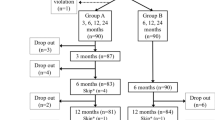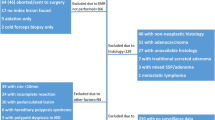Abstract
Background
Endoscopic piecemeal mucosal resection (EPMR) is a widely accepted treatment for colorectal tumefaction. However, as it is associated with a significant recurrence rate, the technique remains controversial. The purpose of our study was to evaluate the risk factors for the local recurrence of colorectal neoplasms after EPMR.
Methods
The study population of our retrospective evaluation comprised 222 patients who had undergone EPMR from January 2002 to July 2007 and who had had at least 1 surveillance colonoscopy 3–6 months after the initial treatment.
Results
Local recurrence was detected in 42 patients (19%) between 6 and 15 months after EPMR. Our multivariate analysis revealed that the resection of 5 or more neoplasm specimens, compared with fewer than 5, was 3 times more likely to result in local recurrence (P = 0.005). No statistically significant correlation of local recurrence with lesion size, location, macroscopic type, or histology was detected.
Conclusion
The removal of 5 or more neoplasm specimens is an independent risk factor for local recurrence after EPMR. Careful colonoscopic surveillance should be performed after multiple piecemeal resection.

Similar content being viewed by others
Explore related subjects
Discover the latest articles and news from researchers in related subjects, suggested using machine learning.References
Saito Y, Fukuzawa M, Matsuda T, Fukunaga S, Sakamoto T, Uraoka T, et al. Clinical outcome of endoscopic submucosal dissection versus endoscopic mucosal resection of large colorectal tumors as determined by curative resection. Surg Endosc. 2010;24(2):343–52.
Saito Y, Uraoka T, Yamaguchi Y, Hotta K, Sakamoto N, Ikematsu H, et al. A prospective, multicenter study of 1111 colorectal endoscopic submucosal dissections (with video). Gastrointest Endosc. 2010;72(6):1217–25.
Tanaka S, Tamegai Y, Tsuda S, Saito Y, Yahagi N, Yamano HO. Multicenter questionnaire survey on the current situation of colorectal endoscopic submucosal dissection in Japan. Dig Endosc. 2010;22(Suppl 1):S2–8.
Ahmad NA, Kochman ML, Long WB, Furth EE, Ginsberg GG. Efficacy, safety, and clinical outcomes of endoscopic mucosal resection: a study of 101 cases. Gastrointest Endosc. 2002;55(3):390–6.
Hurlstone DP, Sanders DS, Cross SS, Adam I, Shorthouse AJ, Brown S, et al. Colonoscopic resection of lateral spreading tumours: a prospective analysis of endoscopic mucosal resection. Gut. 2004;53(9):1334–9.
Kiesslich R, Neurath MF. Endoscopic mucosal resection: an evolving therapeutic strategy for non-polypoid colorectal neoplasia. Gut. 2004;53(9):1222–4.
Walsh RM, Ackroyd FW, Shellito PC. Endoscopic resection of large sessile colorectal polyps. Gastrointest Endosc. 1992;38(3):303–9.
Hotta K, Fujii T, Saito Y, Matsuda T. Local recurrence after endoscopic resection of colorectal tumors. Int J Colorectal Dis. 2009;24(2):225–30.
Tanaka S, Oka S, Chayama K. Colorectal endoscopic submucosal dissection: present status and future perspective, including its differentiation from endoscopic mucosal resection. J Gastroenterol. 2008;43(9):641–51.
Winawer SJ, Zauber AG, Fletcher RH, Stillman JS, O’Brien MJ, Levin B, et al.; US Multi-Society Task Force on Colorectal Cancer; American Cancer Society. Guidelines for colonoscopy surveillance after polypectomy: a consensus update by the US Multi-Society Task Force on Colorectal Cancer and the American Cancer Society. Gastroenterology. 2006;130(6):1872–85.
Sakamoto T, Saito Y, Matsuda T, Fukunaga S, Nakajima T, Fujii T. Treatment strategy for recurrent or residual colorectal tumors after endoscopic resection. Surg Endosc. 2011;25(1):255–60.
The Paris endoscopic classification of superficial neoplastic lesions: esophagus, stomach, and colon. Gastrointest Endosc. 2003;58(6 Suppl):S3–43.
Luigiano C, Consolo P, Scaffidi MG, Strangio G, Giacobbe G, Alibrandi A, et al. Endoscopic mucosal resection for large and giant sessile and flat colorectal polyps: a single-center experience with long-term follow-up. Endoscopy. 2009;41(10):829–35.
Soetikno RM, Inoue H, Chang KJ. Endoscopic mucosal resection. Current concepts. Gastrointest Endosc Clin N Am. 2000;10(4):595–617, vi.
Tanaka S, Haruma K, Oka S, Takahashi R, Kunihiro M, Kitadai Y, et al. Clinicopathologic features and endoscopic treatment of superficially spreading colorectal neoplasms larger than 20 mm. Gastrointest Endosc. 2001;54(1):62–6.
Tamura S, Nakajo K, Yokoyama Y, Ohkawauchi K, Yamada T, Higashidani Y, et al. Evaluation of endoscopic mucosal resection for laterally spreading rectal tumors. Endoscopy. 2004;36(4):306–12.
Arebi N, Swain D, Suzuki N, Fraser C, Price A, Saunders BP. Endoscopic mucosal resection of 161 cases of large sessile or flat colorectal polyps. Scand J Gastroenterol. 2007;42(7):859–66.
Khashab M, Eid E, Rusche M, Rex DK. Incidence and predictors of “late” recurrence after endoscopic piecemeal resection of large sessile adenomas. Gastrointest Endosc. 2009;70(2):344–9.
Tanaka S, Oka S, Chayama K. Colorectal endoscopic submucosal dissection: present status and future perspective, including its differentiation from endoscopic resection. J Gastroenterol. 2008;43(9):641–51.
Pollard CW, Nivatvongs S, Rojanasakul A, Reiman HM, Dozois RR. The fate of patients following polypectomy alone for polyps containing invasive carcinoma. Dis Colon Rectum. 1992;35(10):933–7.
Ishikawa T, Ushio K, Miyagawa K, Nakashima H, Yokota T, Ono H, et al. Morphological features of local recurrent adenomas and carcinomas of the colon and rectum after polypectomy (in Japanese with English abstract). I Chou. 1993;28:511–22.
Matsuda K, Masaki T, Abo Y, Uchida H, Watanabe T, Muto T. Rapid growth of residual colonic tumor after incomplete mucosal resection. J Gastroenterol. 1999;34(2):260–3.
Tsunada S, Mannen K, Yamaguchi K, Aoki S, Uchihashi K, Toda S, et al. A case of advanced colonic cancer that developed from residual laterally spreading tumor treated by piecemeal endoscopic mucosal resection. Clin J Gastroenterol. 2008;1(1):18–22.
Kunihiro M, Tanaka S, Haruma K, Kitadai Y, Yoshihara M, Sumii K, et al. Electrocautery snare resection stimulates cellular proliferation of residual colorectal tumor: an increasing gene expression related to tumor growth. Dis Colon Rectum. 2000;43(8):1107–15.
Kitajima K, Fujimori T, Fujii S, Takeda J, Ohkura Y, Kawamata H, et al. Correlations between lymph node metastasis and depth of submucosal invasion in submucosal invasive colorectal carcinoma: a Japanese collaborative study. J Gastroenterol. 2004;39(6):534–43.
Matsuda T, Fujii T, Saito Y, Nakajima T, Uraoka T, Kobayashi N, et al. Efficacy of the invasive/non-invasive pattern by magnifying chromoendoscopy to estimate the depth of invasion of early colorectal neoplasms. Am J Gastroenterol. 2008;103(11):2700–6.
Fu KI, Kato S, Sano Y, Onuma EK, Saito Y, Matsuda T, et al. Staging of early colorectal cancers: magnifying colonoscopy versus endoscopic ultrasonography for estimation of depth of invasion. Dig Dis Sci. 2008;53(7):1886–92.
Uraoka T, Saito Y, Matsuda T, Ikehara H, Gotoda T, Saito D, Fujii T. Endoscopic indications for endoscopic mucosal resection of laterally spreading tumours in the colorectum. Gut. 2006;55(11):1592–7.
Saito Y, Uraoka T, Matsuda T, Emura F, Ikehara H, Mashimo Y, et al. Endoscopic treatment of large superficial colorectal tumors: a case series of 200 endoscopic submucosal dissections (with video). Gastrointest Endosc. 2007;66(5):966–73.
Conflict of interest
None.
Author information
Authors and Affiliations
Corresponding author
Rights and permissions
About this article
Cite this article
Sakamoto, T., Matsuda, T., Otake, Y. et al. Predictive factors of local recurrence after endoscopic piecemeal mucosal resection. J Gastroenterol 47, 635–640 (2012). https://doi.org/10.1007/s00535-011-0524-5
Received:
Accepted:
Published:
Issue Date:
DOI: https://doi.org/10.1007/s00535-011-0524-5




